Jay Pathak
A domain decomposition-based autoregressive deep learning model for unsteady and nonlinear partial differential equations
Aug 27, 2024Abstract:In this paper, we propose a domain-decomposition-based deep learning (DL) framework, named transient-CoMLSim, for accurately modeling unsteady and nonlinear partial differential equations (PDEs). The framework consists of two key components: (a) a convolutional neural network (CNN)-based autoencoder architecture and (b) an autoregressive model composed of fully connected layers. Unlike existing state-of-the-art methods that operate on the entire computational domain, our CNN-based autoencoder computes a lower-dimensional basis for solution and condition fields represented on subdomains. Timestepping is performed entirely in the latent space, generating embeddings of the solution variables from the time history of embeddings of solution and condition variables. This approach not only reduces computational complexity but also enhances scalability, making it well-suited for large-scale simulations. Furthermore, to improve the stability of our rollouts, we employ a curriculum learning (CL) approach during the training of the autoregressive model. The domain-decomposition strategy enables scaling to out-of-distribution domain sizes while maintaining the accuracy of predictions -- a feature not easily integrated into popular DL-based approaches for physics simulations. We benchmark our model against two widely-used DL architectures, Fourier Neural Operator (FNO) and U-Net, and demonstrate that our framework outperforms them in terms of accuracy, extrapolation to unseen timesteps, and stability for a wide range of use cases.
Large scale scattering using fast solvers based on neural operators
May 20, 2024Abstract:We extend a recently proposed machine-learning-based iterative solver, i.e. the hybrid iterative transferable solver (HINTS), to solve the scattering problem described by the Helmholtz equation in an exterior domain with a complex absorbing boundary condition. The HINTS method combines neural operators (NOs) with standard iterative solvers, e.g. Jacobi and Gauss-Seidel (GS), to achieve better performance by leveraging the spectral bias of neural networks. In HINTS, some iterations of the conventional iterative method are replaced by inferences of the pre-trained NO. In this work, we employ HINTS to solve the scattering problem for both 2D and 3D problems, where the standard iterative solver fails. We consider square and triangular scatterers of various sizes in 2D, and a cube and a model submarine in 3D. We explore and illustrate the extrapolation capability of HINTS in handling diverse geometries of the scatterer, which is achieved by training the NO on non-scattering scenarios and then deploying it in HINTS to solve scattering problems. The accurate results demonstrate that the NO in HINTS method remains effective without retraining or fine-tuning it whenever a new scatterer is given. Taken together, our results highlight the adaptability and versatility of the extended HINTS methodology in addressing diverse scattering problems.
Diffusion model based data generation for partial differential equations
Jun 19, 2023



Abstract:In a preliminary attempt to address the problem of data scarcity in physics-based machine learning, we introduce a novel methodology for data generation in physics-based simulations. Our motivation is to overcome the limitations posed by the limited availability of numerical data. To achieve this, we leverage a diffusion model that allows us to generate synthetic data samples and test them for two canonical cases: (a) the steady 2-D Poisson equation, and (b) the forced unsteady 2-D Navier-Stokes (NS) {vorticity-transport} equation in a confined box. By comparing the generated data samples against outputs from classical solvers, we assess their accuracy and examine their adherence to the underlying physics laws. In this way, we emphasize the importance of not only satisfying visual and statistical comparisons with solver data but also ensuring the generated data's conformity to physics laws, thus enabling their effective utilization in downstream tasks.
NLP Inspired Training Mechanics For Modeling Transient Dynamics
Nov 04, 2022Abstract:In recent years, Machine learning (ML) techniques developed for Natural Language Processing (NLP) have permeated into developing better computer vision algorithms. In this work, we use such NLP-inspired techniques to improve the accuracy, robustness and generalizability of ML models for simulating transient dynamics. We introduce teacher forcing and curriculum learning based training mechanics to model vortical flows and show an enhancement in accuracy for ML models, such as FNO and UNet by more than 50%.
A composable machine-learning approach for steady-state simulations on high-resolution grids
Oct 11, 2022



Abstract:In this paper we show that our Machine Learning (ML) approach, CoMLSim (Composable Machine Learning Simulator), can simulate PDEs on highly-resolved grids with higher accuracy and generalization to out-of-distribution source terms and geometries than traditional ML baselines. Our unique approach combines key principles of traditional PDE solvers with local-learning and low-dimensional manifold techniques to iteratively simulate PDEs on large computational domains. The proposed approach is validated on more than 5 steady-state PDEs across different PDE conditions on highly-resolved grids and comparisons are made with the commercial solver, Ansys Fluent as well as 4 other state-of-the-art ML methods. The numerical experiments show that our approach outperforms ML baselines in terms of 1) accuracy across quantitative metrics and 2) generalization to out-of-distribution conditions as well as domain sizes. Additionally, we provide results for a large number of ablations experiments conducted to highlight components of our approach that strongly influence the results. We conclude that our local-learning and iterative-inferencing approach reduces the challenge of generalization that most ML models face.
A Thermal Machine Learning Solver For Chip Simulation
Sep 10, 2022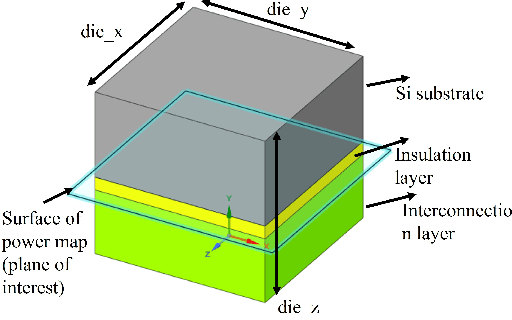
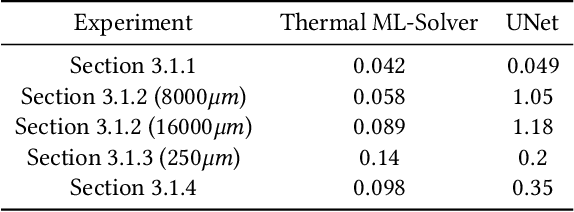
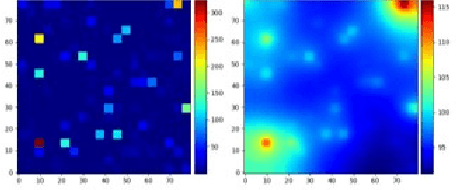
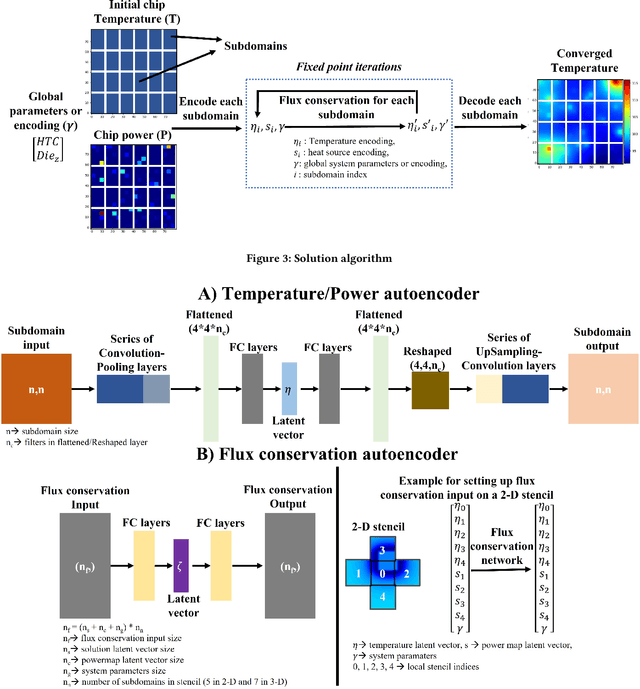
Abstract:Thermal analysis provides deeper insights into electronic chips behavior under different temperature scenarios and enables faster design exploration. However, obtaining detailed and accurate thermal profile on chip is very time-consuming using FEM or CFD. Therefore, there is an urgent need for speeding up the on-chip thermal solution to address various system scenarios. In this paper, we propose a thermal machine-learning (ML) solver to speed-up thermal simulations of chips. The thermal ML-Solver is an extension of the recent novel approach, CoAEMLSim (Composable Autoencoder Machine Learning Simulator) with modifications to the solution algorithm to handle constant and distributed HTC. The proposed method is validated against commercial solvers, such as Ansys MAPDL, as well as a latest ML baseline, UNet, under different scenarios to demonstrate its enhanced accuracy, scalability, and generalizability.
A Hybrid Iterative Numerical Transferable Solver (HINTS) for PDEs Based on Deep Operator Network and Relaxation Methods
Aug 28, 2022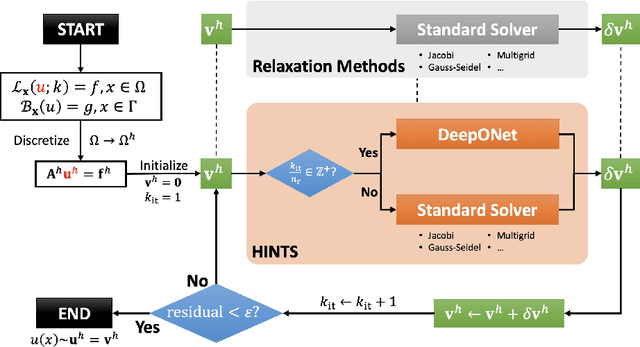
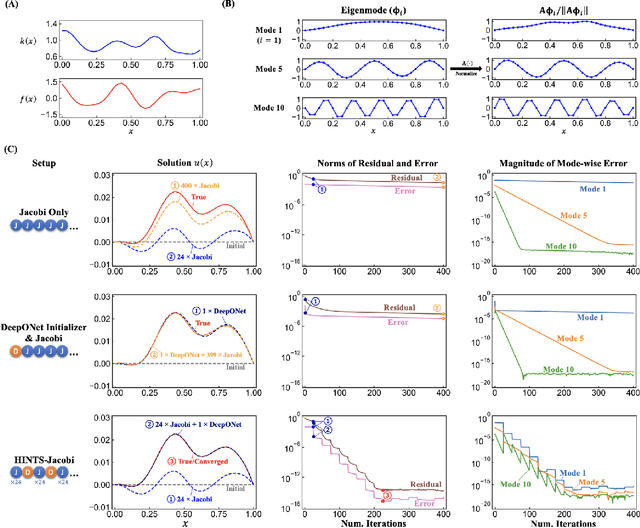
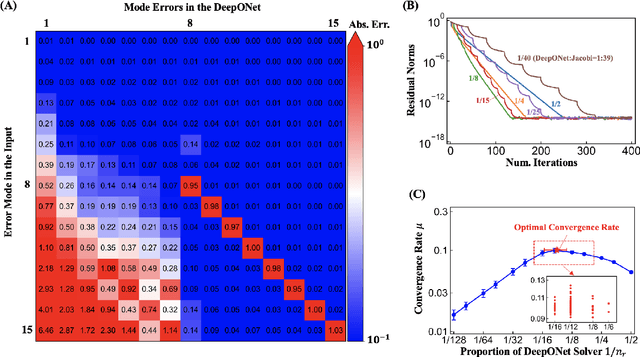
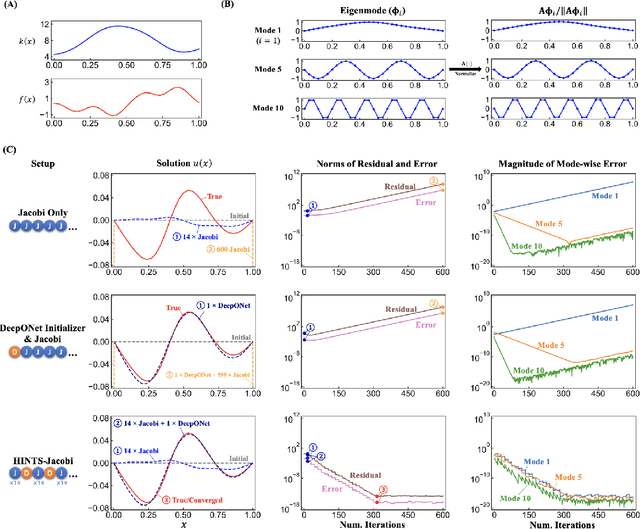
Abstract:Iterative solvers of linear systems are a key component for the numerical solutions of partial differential equations (PDEs). While there have been intensive studies through past decades on classical methods such as Jacobi, Gauss-Seidel, conjugate gradient, multigrid methods and their more advanced variants, there is still a pressing need to develop faster, more robust and reliable solvers. Based on recent advances in scientific deep learning for operator regression, we propose HINTS, a hybrid, iterative, numerical, and transferable solver for differential equations. HINTS combines standard relaxation methods and the Deep Operator Network (DeepONet). Compared to standard numerical solvers, HINTS is capable of providing faster solutions for a wide class of differential equations, while preserving the accuracy close to machine zero. Through an eigenmode analysis, we find that the individual solvers in HINTS target distinct regions in the spectrum of eigenmodes, resulting in a uniform convergence rate and hence exceptional performance of the hybrid solver overall. Moreover, HINTS applies to equations in multidimensions, and is flexible with regards to computational domain and transferable to different discretizations.
A composable autoencoder-based iterative algorithm for accelerating numerical simulations
Oct 07, 2021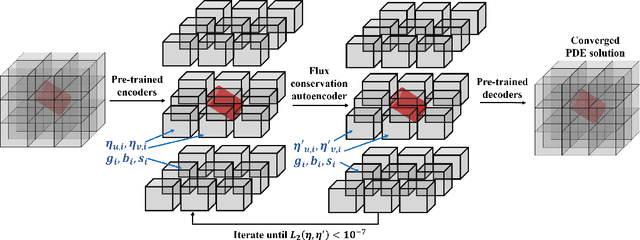



Abstract:Numerical simulations for engineering applications solve partial differential equations (PDE) to model various physical processes. Traditional PDE solvers are very accurate but computationally costly. On the other hand, Machine Learning (ML) methods offer a significant computational speedup but face challenges with accuracy and generalization to different PDE conditions, such as geometry, boundary conditions, initial conditions and PDE source terms. In this work, we propose a novel ML-based approach, CoAE-MLSim (Composable AutoEncoder Machine Learning Simulation), which is an unsupervised, lower-dimensional, local method, that is motivated from key ideas used in commercial PDE solvers. This allows our approach to learn better with relatively fewer samples of PDE solutions. The proposed ML-approach is compared against commercial solvers for better benchmarks as well as latest ML-approaches for solving PDEs. It is tested for a variety of complex engineering cases to demonstrate its computational speed, accuracy, scalability, and generalization across different PDE conditions. The results show that our approach captures physics accurately across all metrics of comparison (including measures such as results on section cuts and lines).
Geometry encoding for numerical simulations
Apr 15, 2021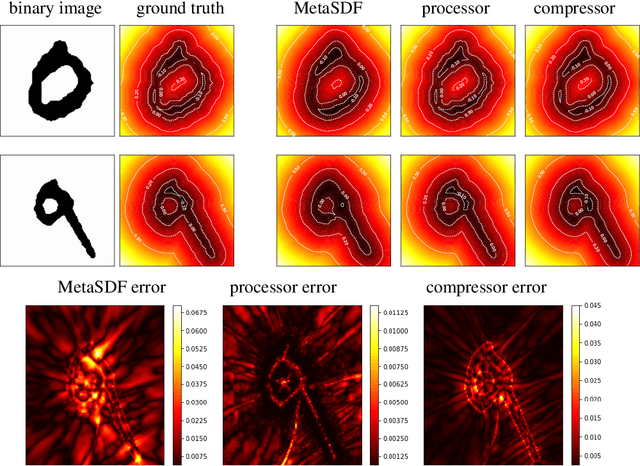

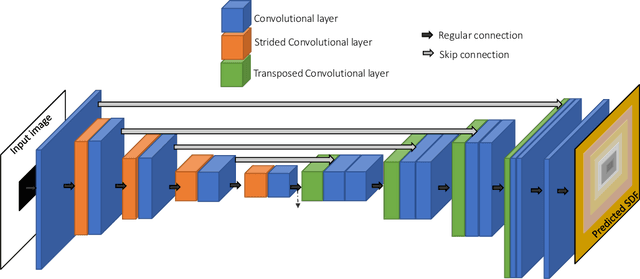
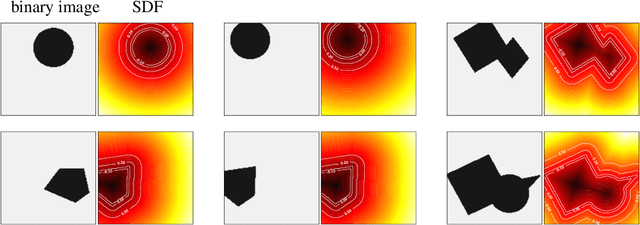
Abstract:We present a notion of geometry encoding suitable for machine learning-based numerical simulation. In particular, we delineate how this notion of encoding is different than other encoding algorithms commonly used in other disciplines such as computer vision and computer graphics. We also present a model comprised of multiple neural networks including a processor, a compressor and an evaluator.These parts each satisfy a particular requirement of our encoding. We compare our encoding model with the analogous models in the literature
One-shot learning for solution operators of partial differential equations
Apr 06, 2021

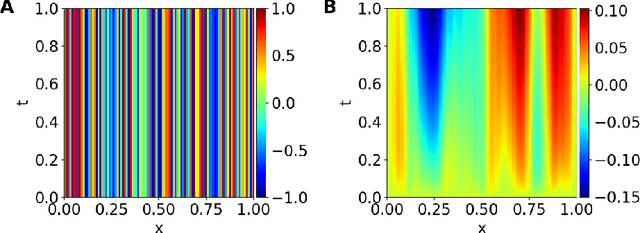

Abstract:Discovering governing equations of a physical system, represented by partial differential equations (PDEs), from data is a central challenge in a variety of areas of science and engineering. Current methods require either some prior knowledge (e.g., candidate PDE terms) to discover the PDE form, or a large dataset to learn a surrogate model of the PDE solution operator. Here, we propose the first learning method that only needs one PDE solution, i.e., one-shot learning. We first decompose the entire computational domain into small domains, where we learn a local solution operator, and then find the coupled solution via a fixed-point iteration. We demonstrate the effectiveness of our method on different PDEs, and our method exhibits a strong generalization property.
 Add to Chrome
Add to Chrome Add to Firefox
Add to Firefox Add to Edge
Add to Edge